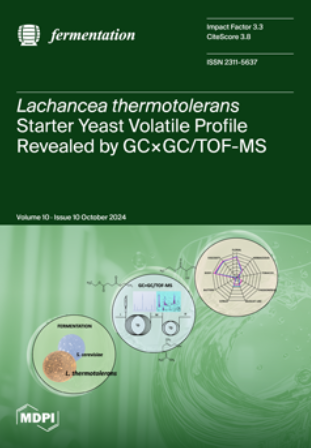Effect of Condensed Tannins on Nitrogen Distribution and Metabolome after Aerobic Exposure of Sainfoin Silage
IF 3.3
3区 农林科学
Q2 BIOTECHNOLOGY & APPLIED MICROBIOLOGY
引用次数: 0
Abstract
(1) Background: Previous studies have indicated that proteolysis is inhibited by the condensed tannins (CTs) that are present during sainfoin ensiling. Whether inhibiting this effect of CTs on proteolysis is functional during aerobic exposure is still unclear. (2) Methods: the present study investigated the effect of CTs on metabolite composition during the aerobic exposure of sainfoin silage via the use of polyethylene glycol (PEG), leading to the inactivation of CTs. (3) Results: The neutral detergent-insoluble protein (NDIP) and acid detergent-insoluble protein concentrations were both more concentrated in the control group than in the PEG-treated group. There were 587 and 651 different metabolites present in the control and PEG-treated groups after 3 and 7 days, respectively, of aerobic exposure of silage. Flavonoids (72 metabolites) were the most abundant among these different metabolites. The addition of PEG upregulated histidine, threonine, asparagine, tryptophan, and glutamine, but downregulated phenylalanine. The relative abundances of Lactococcus, Fructobacillus, Enterobacter, Cutibacterium, Citrobacter, and Rosenbergiella differed significantly between the control and PEG-treated groups (p < 0.05); all of these bacteria showed significant correlation with some of the 50 most abundant metabolites. (4) Conclusions: the results suggest that the antioxidant status of the silage increased and inhibited the activity of a variety of bacteria that coexist with CTs, and decreased the production of certain amino acids after the aerobic exposure of silage.浓缩单宁对赛恩芬青贮好氧暴露后氮分布和代谢组的影响
(1) 背景:先前的研究表明,在海燕蛋白青贮过程中存在的缩合单宁(CT)会抑制蛋白水解。在有氧暴露期间,抑制CTs对蛋白水解的这种作用是否具有功能尚不清楚。(2) 方法:本研究通过使用聚乙二醇(PEG),研究了在有氧暴露于sainfoin青贮饲料期间,CTs对代谢产物组成的影响,从而导致CTs的失活。(3) 结果:对照组中性洗涤剂不溶性蛋白(NDIP)和酸性洗涤剂不溶蛋白的浓度均高于PEG处理组。青贮饲料有氧暴露3天和7天后,对照组和PEG处理组分别存在587和651种不同的代谢产物。黄酮类化合物(72种代谢产物)在这些不同的代谢产物中含量最高。PEG的加入上调了组氨酸、苏氨酸、天冬酰胺、色氨酸和谷氨酰胺,但下调了苯丙氨酸。乳球菌、果杆菌、肠杆菌、Cutibacterium、柠檬酸杆菌和Rosenbergiella的相对丰度在对照组和PEG处理组之间存在显著差异(p<0.05);所有这些细菌都与50种最丰富的代谢产物中的一些表现出显著的相关性。(4) 结论:青贮饲料的抗氧化状态增加和抑制了与CTs共存的多种细菌的活性,并降低了青贮饲料好氧暴露后某些氨基酸的产生。
本文章由计算机程序翻译,如有差异,请以英文原文为准。
求助全文
约1分钟内获得全文
求助全文
来源期刊

Fermentation-Basel
BIOTECHNOLOGY & APPLIED MICROBIOLOGY-
CiteScore
3.80
自引率
18.90%
发文量
594
审稿时长
7 weeks
期刊介绍:
Fermentation-Basel is an international open access journal published by MDPI, focusing on fermentation-related research, including new and emerging products, processes and technologies, such as biopharmaceuticals and biotech drugs. The journal enjoys a good reputation in the academic community and provides a high-impact forum for researchers in the field of bioengineering and applied microbiology.
 求助内容:
求助内容: 应助结果提醒方式:
应助结果提醒方式:


